
San Marzano - Red Mid-season Tomato
This vigorous tomato variety bears clusters of elongated red fruit, 6 to 7 cm long. San Marzano is resistant to shattering, suitable for drying and making tomato preserves and sauces. Its firm, dense flesh has a mild flavor.
What are the characteristics of the San Marzano mid-season red tomato?
The San Marzano red tomato (from the Latin Solanum lycopersicum) is a mid-season variety from Italy. Introduced into Glecklers Seedmen's Tomato and Strange Plant Emporium catalog in 1958, it is now popular in the preparation of tomato sauces. Highly resistant to disease and shattering, San Marzano adapts well to all types of soil. This indeterminate-growth variety produces elongated red fruits with firm flesh.
How to sow San Marzano tomato seeds?
San Marzano red tomato seeds should be sown in pots or trays, under a light shelter, at a temperature of between 16 and 20°C. Sow between February and April.
- Bury seeds 5-7 mm deep in potting soil;
- Water seedlings thoroughly;
- Grow tomatoes indoors under a light source or in a heated greenhouse;
- Transplant into pots when plants reach the stage of 2 to 4 true leaves. Bury the stem up to the two cotyledons to encourage root development and keep the plants out of the cold;
- For 4 to 7 days before planting, take the plants outside during the day to acclimatize them to the outdoors;
- As soon as the plants are strong, transplant the whole clump into the ground in full sunlight, after the last frosts (ice saints in May). Greenhouse plants can be transplanted when indoor temperatures no longer fall below 10°C;
- Keep a minimum distance of 50 cm between plants, burying the stem up to the first leaves;
- Water tomatoes regularly after planting, without touching foliage or flowers.
How to grow San Marzano tomatoes?
Although vigorous, the San Marzano red tomato variety can be affected by diseases such as downy mildew or apical necrosis, also known as black-bottom.
The most widespread disease, downy mildew, is a fungus in the form of brown spots that appears on the foliage and then on the stem. Downy mildew occurs particularly in wet summers. The best way to avoid it is to limit the accumulation of humidity by :
- Tomatoes under ventilated shelter or sunny exposure;
- Sufficient distance between tomato plants;
- Mulching or staking to prevent lower leaves from touching the ground.
Comfrey purin can also be used as a preventive treatment.
The second problem is caused by irregular watering of plants, leading to mineral deficiency. Apical necrosis appears as black spots on the tips of the fruit. Remove those affected and resume regular, but not excessive, watering.
To boost the immune defenses of San Marzano tomatoes and protect them from fungal diseases, we recommend using horsetail decoction and nettle manure. Combining the crop with companion plants such as basil is another way of keeping pests at bay.
How to store and eat San Marzano tomatoes?
San Marzano red tomatoes are harvested from June to October. The fruits, renowned for their mild flavor and firm flesh, contain few seeds. This vegetable can be eaten both raw and cooked, but many people use them to make sauces, juices and canned coulis. Be sure to sterilize glass jars by immersing them in boiling water before pouring in the tomatoes.
These products may also be of interest to you
in bucket
Sow in pots at a temperature of between 16 and 20°C, under a well-lit shelter, 5 weeks before planting. After the last frosts, transplant the whole clump into the ground at a minimum distance of 50 cm, burying the stem up to the first leaves. Water abundantly at the time of planting.
Solanaceae need light and heat to produce. In cool climates, it's best to grow them under cover and, depending on the soil, water them regularly.
February, March, April
June, July, August, September, October
in the ground, in the greenhouse
full sun
medium
all floor types
drained, rich, reheated
Solanum lycopersicum
mid-season
35 seeds
cylindrical
farm
indeterminate
Red
From 6 to 10 cm
regular
Italy
"Tomato and Strange Plant Emporium" Glecklers Seedmen










